The unemployment numbers for January were in line with last month’s forecast, and the contour of the forecast remains unchanged. The slight uptick only reflects the inertial dynamics of unemployment and is likely an aftermath of Hurricane Sandy. With a slow but steady improvement in hiring, I project a slow but steady improvement in the labor market and an unemployment rate of 7.4% in September 2013.
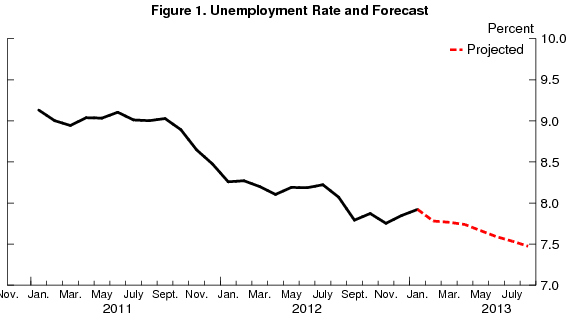
This post discusses my monthly update of the Barnichon-Nekarda model. For an introduction to the basic concepts used in this post, read my introductory post (Full details are available here.)
As expected (see last month forecast in Table 1 and my post here), the unemployment rate ticked up to 7.9% in January. This slight increase reflects the dynamics of unemployment and is no cause for worry. The intuition for this uptick is easily understood by looking at the behavior of the “steady-state” unemployment rate. The steady-state unemployment rate, the rate of unemployment implied by the underlying labor force flows—the blue line in figure 5—hovered around 8 percent in the past couple months and was above the actual unemployment rate. This is mostly because workers’ job finding rates (i.e, hiring) declined sharply in November (probably reflecting the effect of Hurricane Sandy) and because worker’s separation rate (layoffs) increased sharply in November (probably also related to Sandy). Our research shows that the actual unemployment rate converges toward the steady state unemployment rate, and this convergence process generates some inertia in the behavior of unemployment. At December’s level of 7.8 percent (Table 1), the unemployment rate was slightly above its steady-state rate, which pushed up the unemployment rate up in January. In other words, the January uptick is simply a late effect of Hurricane Sandy.
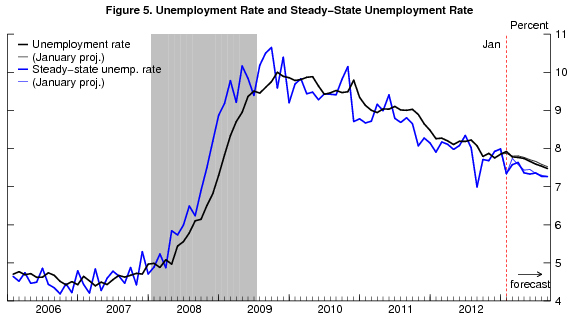
However, the current value of steady-state unemployment rate is now significantly lower (at 7.4%), and the “steady-state convergence dynamic” is now pushing the unemployment rate down. With a projected steady-state unemployment rate at 7.2 percent in September 2013, I project the unemployment rate to slowly decrease over the coming months and to reach 7.4 percent in September.
More precisely, the model propagates forward its best estimate for how the flows between employment, unemployment and out-of-the labor force will evolve over time, and constructs the implications for the unemployment rate. In January, job openings have increased, and new claims for unemployment insurance continued their decline. Consequently, the model now projects sizable improvements in workers’ job finding rates (figure 3) over the next 6 months, and the outlook for the job separation rate (or layoffs) is improving (albeit, very slowly, figure 2). As a result, the steady-state unemployment rate is now projected to decline to 7.2% by September 2013, bringing the unemployment rate down with it.
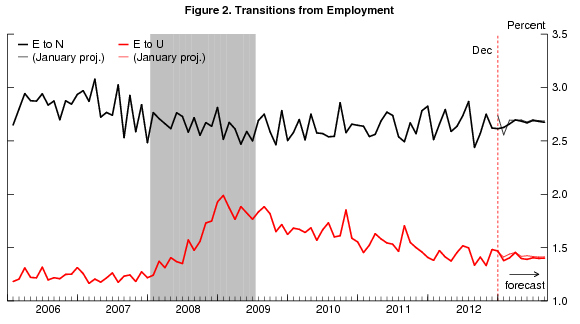
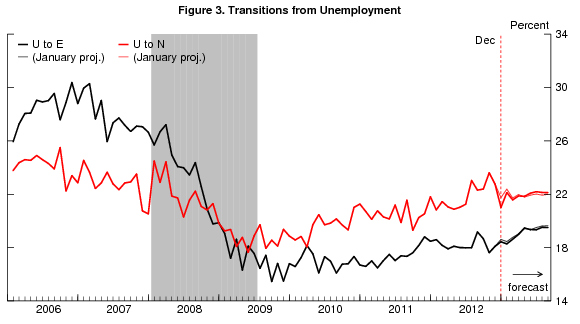
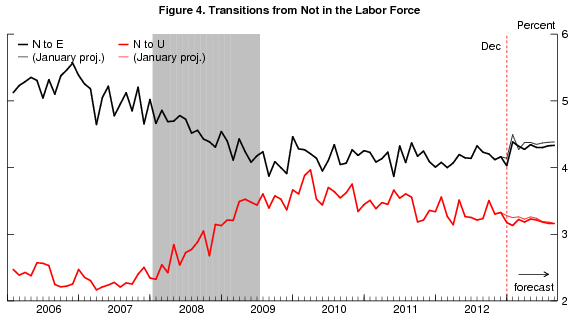

To read more about the underlying model and the evidence that it outperforms other unemployment rate forecasts, see Barnichon and Nekarda (2012).
The Brookings Institution is committed to quality, independence, and impact.
We are supported by a diverse array of funders. In line with our values and policies, each Brookings publication represents the sole views of its author(s).



Commentary
Labor Market Keeps Improving: Unemployment Uptick Normal, Reflects the Dynamics of Unemployment Inertia
February 1, 2013